I have implemented a multiline text editor for a QTableView as seen here: Make row of QTableView expand as editor grows in height
One issue I have not yet been able to solve is getting full control over the styling of the painted text. A solution for the font color was provided here: Changing the font color of a QTableView after replacing the default editor with an ItemDelegate QTextEdit in PyQt5
I have set a stylesheet for the QTableView:
self.setStyleSheet(
"""font-size: 14px;
gridline-color: rgb(60, 60, 60);"""
)
And it works for styling the editor as well as the grid. Ideally, I would like the cells to have the same styling as the rest of the application while having some way of making changes to some of the attributes which would then affect both the editor and the way the cells are painted. Everything I have done so far in order to change the styling of the font has been ignored. I have tried changing the initStyleOption, changing the painter's font, changing the option's font and everything else I could think of.
This is the current paint function:
def paint(self, painter, option, index):
"""
Method override
"""
# Remove dotted border on cell focus. https://stackoverflow.com/a/55252650/3620725
if option.state & QtWidgets.QStyle.State_HasFocus:
option.state = option.state ^ QtWidgets.QStyle.State_HasFocus
self.initStyleOption(option, index)
painter.save()
doc = QtGui.QTextDocument()
doc.setDocumentMargin(3)
doc.setTextWidth(option.rect.width())
# changed to setPlainText from setHtml because setHtml was removing all newlines
doc.setPlainText(option.text)
option.text = ""
option.widget.style().drawControl(
QtWidgets.QStyle.CE_ItemViewItem, option, painter
)
painter.translate(option.rect.left(), option.rect.top())
clip = QtCore.QRectF(0, 0, option.rect.width(), option.rect.height())
painter.setClipRect(clip)
layout = doc.documentLayout()
ctx = layout.PaintContext()
ctx.palette = option.palette
layout.draw(painter, ctx)
painter.restore()
An application wide stylesheet is applied when the program is run:
app = QApplication(sys.argv)
app.setStyleSheet(qtstylish.dark())
I believe the spacing is also different between the editor and the painted cell.
